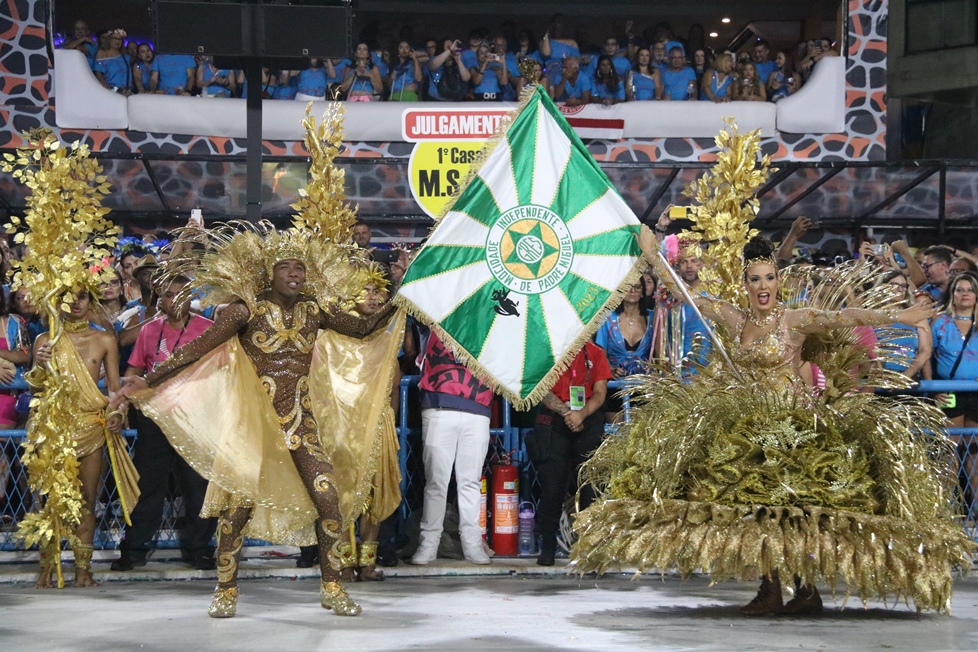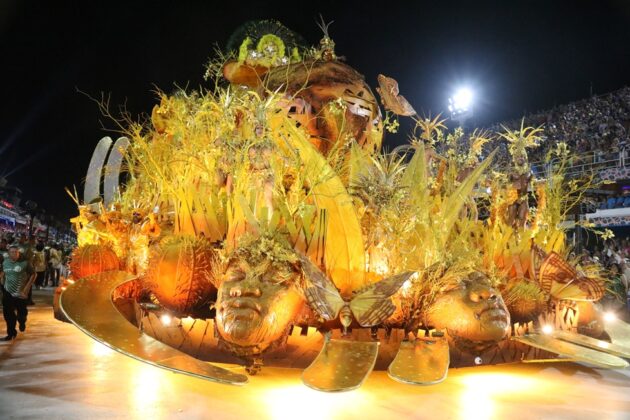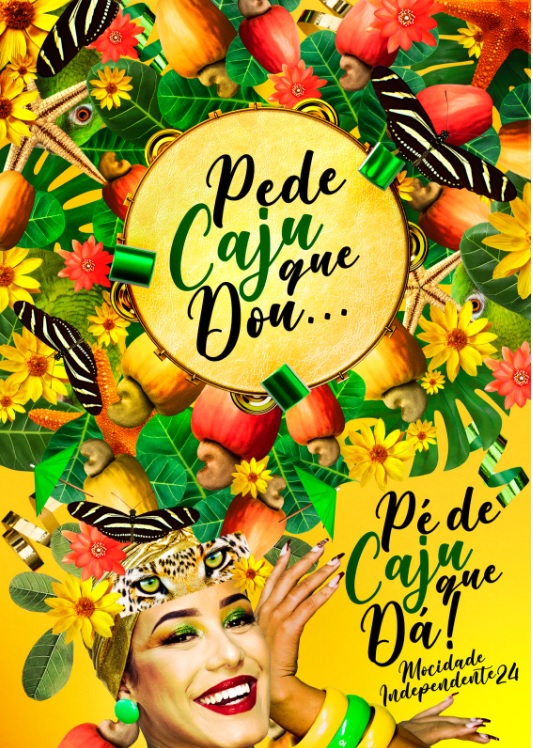- Your cart is empty
- Continue Shopping
Youth






Technical Sheet 2024
- Plot: “Ask for cashews and I’ll give them to you… cashew trees give them to you!”
- Carnivalesque: Marcus Ferreira
- President: Flavio da Silva Santos
- Vice President: Luiz Claudio Ribeiro
- Honorary President: Rogerio Andrade
- Directors of Harmony: Wallace Capoeira
- Interpreter: Joe Paulo Sierra
- Drum Master: Dudu Oliveira
- Drum Queen: Giovana Angelica
- Master of Ceremonies and Flag Bearer: Diogo Jesus and Bruna Santos
- Front Committee: Paul Pinna
“Ask for cashews and I’ll give them to you… cashew trees give them to you!”

GRES YOUTH IDENTIFYING WITH FATHER MIGUEL | Carnival 2024
Synopsis – SUMMARY
Cashew meat
The poet always looks to his own land when he weaves lyrics and takes flight. It is only natural that he and his partners, in addition to other inspirations, sought a native fruit, abundant and with a certain physical whim to explode in colors the entire tropicalist revolution. Of course! The bittersweet succulence that seduces the lips, proclaims science, is a mere accessory trinket. The fruit, hard, is on top, like a headdress, black power or crown: the chestnut. But who is foolish enough not to get licked with everything?
On the ground of equally striking inversions and art that began to transgress and highlight the depths of Brazilianness, our carnivalized message is on the table: the anthropophagic whirlwind of Tropicália has also sunk its teeth into cashew meat. Yes, we have it for chayote! From there, let's bite into it and feel the country of so many portions and flavors? Broth of honey and bitterness, like everyday life, “the tropical morning begins. Resplendent, falling, glowing, in a sunflower heat with joy. In the general Brazilian jelly that Jornal do Brasil announces…”.
There is a cashew tree with a green crown on the left side of every breast, they say. It looks like a kidney, but it is an invitation to sin. Tree cashew, dwarf cashew, creeping cashew, big or shy cashew, yellow, pink or very red cashew. The protagonist of a sonnet composed, perhaps, in Vinicius' bathtub: "consistency of a dick and carries a ball in nature". Elementary materialism in reverse. What a stain, what a burn, what an abundance! That rains. Exaggerated and upright. Tupi acayu on a stick.
Cajuí or not cajuí, that is the question! We will make it a carnival!Anacardium occidentale
And let’s dive into the past told in chestnuts by so many native peoples. Each cashew in the gourd, a spring. The Porã tribe, expelled from their place of origin, only found happiness when the chestnuts kept by the wise Tamandaré (their grandfather), which had been lost until then, blossomed. Then came the time of cashews, of generosity, since the “nut that produces itself”, in addition to the basics of botany, sows abundance, memories and affection. In the ceremonies involving the Torém, a sacred ritual of the Tremembés, the spirits of those who sang to ascend chat with the living. The unbridled drinking of mocororó, or cashew wine, hydrates the roots of traditions – since the festival clashes with the harvest season.
The wise say that hordes from the interior sought the coastline adorned by the overgrown trees. The so-called “Caju Wars” arose thus, and before Cabral, but gained astringency when the thirteen ships appeared on the horizon. Then, the evil eye grew to the order of tons! The Portuguese soon got his mustache wet with interest. The Frenchman, mon amour, put it in his mouth, stained his pockets and signed it in a famous illustration. As for the real owner of the land… Well, all that was left was to fight – club in hand – against the mummies of institutionalized thievery, our historical bitterness.
And we haven't even mentioned the Dutch, another who didn't make a fool of himself in that mess: Nassau took care of the legislation, stamped it and sent the inflated gift to his people. With the wind blowing against the tide, the invasion was arranged – the pioneering caju making an epic and posing as the Tupiniquim Caju Fruit Company – by the opposite route of the great navigations. Return in sight! The natural Brazilian Way Of Life revered with compliments and enhanced on the other side of the ocean by monarchs and subjects.King cashew
But if even the not-so-clean D. João would take a naughty cat bath at the old Praia do Caju (with the intention of curing his tick bites), and Pedro II was portrayed as Pedro Caju in the cartoons of the 19th century… The fruit wanted to establish its reign in these parts. In Pirangi do Norte (upper coastal corner of the country), in the year of the liberation of slaves, a fisherman named Luiz Inácio planted the darn thing that wore the banner of “Largest Cashew Tree in the World”. Instead of climbing, the branches stretched out to the sides, with new roots appearing when they touched the ground. It started to grow without restraint. The “octopus” from Rio Grande do Norte with its fragrant tentacles became famous and enumerates harvests that disappear from memory, a kind of endless redo. About the fisherman with the same name as the president, the days went by always close to the improbable creation. Once, when he was quite old, he sat down to rest in the shade of one of the branches and never woke up again. A life cycle scented by the sentinel tree.
Everything seemed calm, but then a dispute arose. The typical duel between boys in short pants over who has the most prominent torso among the kids. Recently, the self-proclaimed “King Cashew Tree”, on the fringes of the Parnaíba Delta, tried to claim the top of the ramp as the tape measure champion. In this case, there is also a tragic indigenous legend to go around: it is said in the surrounding area that – surrounded by a sea of seahorses, manatees, turtles and dolphins – two warriors fought for the love of the cunhã-poranga Jacira. It ended in tragedy accompanied by a miracle. After the dispute, the loser ambushed his rival and his beloved during a trip to pick cashews. Two arrows and they both died. Then, the storm full of lightning and thunder the following day produced a magical scene: in the exact place where the couple was buried, the plant of extraordinary size emerged. Does anyone doubt it?
The cashew tree misunderstanding inspires organized fan groups, far-fetched theories that make biologists struggle a lot in their explanations, such as “measure here, measure there” far from the referee’s final whistle. But, while there is no ruler with the appropriate amen on both sides, the game is good for the commodity cashew and its popstar stalk: they continue to be audience champions among foreign and Brazilian palates. Authentic kings of the world. Cashew kings.
Brazilian cashew
Amidst fights and stories of the wisdom of the people – with deliriums due to excess fermented cashew in ideas or incontestable truths –, the legitimate son of this giant village stuck like a “noda”. Expression of collective memory, on the honeyed lips of literature, muscular economy, spotlight of angels or demons that connect us to the feeling and warmth of the nation. Chestnut-motherland, cashew-fatherland. Confidants of the deep inner backyards.
In the twists and turns of destiny and the follies of Macunaíma, such a metaphor for Brazilian routine, ah!, there is the cashew, marking and winding its contradictory steps. Anti-hero-accompanying mirror. Brazilian cashew also on the tightrope with paintbrush in hand: Tarsila's modernist fair in contrast with the memorial "cica" of Debret's melancholic watercolor depicting slavery. There are so many cashews in the many layers on canvas! Canvases, obviously, of the purest real life extracted from the tree. Ask for cashew and I'll give, cashew tree that gives. Give on a canvas of cashew-caipi-pop, industrially turned inwards, while the legs don't wobble: the very encyclopedia of post-doctorate friends in the discipline tongue-twisting. Consistent, sliced, of the plate and the pulp, a wild and closed flavor, which enchants both sweet and salty. For those who collectively crack chestnuts – an allegory of the chronological wheel –, I like shared belonging and bonds. Or just a piece, whatever.
The cashew family screen. Vitamin, superstition and mixture that inflame us. Of soft drinks, liqueur, juice. “Guava paste for dessert…”. The chord of the guitar whispering longing. And even a neatly arranged compote, ribbon and all. Mom’s medicine. A recipe passed down as an inheritance in a yellowed notebook that you don’t even lend to your best friend. A subject-link between the street and the porch. A tablecloth spread out and your mouth waters. Cachaça. Watering a popular game or religious manifestation: from a fair to a curimba, from a samba to a drum on the corner of your house.
The caju-moleque screen. With a platter of cashew nuts to perfume the experience of the experienced – “when you went to get cashews, I would come back with roasted nuts”. It also became a direct message to the idiot who decides to fight for no reason: “hey, go have some cashews!” And the block continues! It goes around the square and embraces the central cashew tree, leaning over the brawl like a flirtatious host. Little faces glued to the softness of the songbook, the end of the dance brings the kiss of the tropical brunette, just look. Soft skin, sweet saliva, yes, I will enjoy you. “Ô, iô, iô, iô…”.General jelly
It is only natural that the general jelly of flavors above does indeed have the soul of Tropicália, and then we think of the poet again: “what is our existence for?”. The existentialist doubt in the face of the ambivalence of the fruit-not-fruit seems like an extract of ours sucked through a straw with that naughty little noise. Well, fundamentally, we exist based on popular culture and the exuberant wealth of the fertile land, even if neglected. Behold, Brazilzão looks at the crystal clear water of the Atlantic and there it is, naked and shameless: it is the never-forbidden cashew itself. Mischievous in its dealings, somewhat mischievous, “totoso” in total.
What mystery does the continental land possess that enjoys a thriving flora like fireworks, and is numbed by the energy of the people in the madness of being? A fiery mixed salad of ambulant cries that sell and consume fertility, it is a peddler of pleasures to the core. The clumsy alchemy of the young man pretending to be a master cat at the caipirinha stand: “sugar, sir?” To waste cajuina life immersed in a delirious procession made in sun and sea, parade in the sand, mermaid curves, juice and grip.
Cheers to the tropical paradise that gives everything and to the state of untamable celebration in the relationship between people and land – the best cashew from the tree of Brazil. Or would it be the best Brazil from the old cashew tree?
A joyful gaiteira, let's face it, has already been experienced in the bustling terrain of the independents. We just need to “look at each other's intact retina”.
On the head, a star. On the soft body, the swaying of the dancer and the pulse of the drum. How about the delicious carnival meat, the permitted salivation, licking your lips far from any hint of guilt?
Here I am, “cajuinamente”, served on a platter with the dose of magic that made me a desired banquet since I was a girl.
Go, hottest beat, and see if you can carry the aroma of the dreamed reunion with myself: I am a gift that spreads like a cashew. I am the sweetest and sexiest fruit of the capital of revelry. I am the one who bites your heart…
School Titles
2017
Champion
1991
Champion
1985
Champion
1996
Champion
1990
Champion
1979
Champion
Technical Sheet
- Foundation: 10/11/1955
- Colors: Green and White
- President: Flavio da Silva Santos
- Block: Brazil Avenue, 31,146 – Realengo – Rio de Janeiro, RJ – Zip Code 21725-001
- Essays:–
- Shed:Samba City (Warehouse No. 10) – Rivadávia Correa Street, No. 60 – Gamboa – ZIP Code: 20.220-290
The History of Youth
In 1956, she presented the theme “Castro Alves”, again in a local parade. In 1957, at Praça Onze, she participated for the first time in the official parade in Rio de Janeiro, with the theme “O Baile das Rosas” winning 5th place in the access group. In 1958, she was champion of the access group with the theme “Apoteose ao Samba”, but what really marked this carnival was that it was held, for the first time under the command of Mestre André, the famous “paradinha da bateria” in front of the judging committee.
The crowd went wild later, following the “bossa” with the cry of “Olé”. During this period, Mocidade was known as “a percussion group that carried the school on its back”, because the percussion group was better known than the school itself. It was only a few years later that it was able to compete with the big ones of the time (Portela, Mangueira, Salgueiro, and Império Serrano). After the “paradinha” created by Mestre André, the “paradinha” was adopted years later by other samba schools, and today all the percussion groups of the samba schools in Rio de Janeiro and Brazil do it.
In 1974, with carnival designer Arlindo Rodrigues, the show presented the theme “A festa do Divino” (The Divine Party), coming in 5th place. But this year, it could have won the championship if it hadn’t gotten a score of 4 in costumes – which was considered a scandal at the time, since Arlindo was known and renowned for his good taste and refinement in costumes. The champion Salgueiro had only 4 points more than Mocidade, that is, a simple 8 in costumes would have given the title to Padre Miguel, since in the tiebreaker, the heat, Salgueiro had 9 and Mocidade 10.
From then on, the school was no longer known only for its drum section, but established itself as a major samba school. In 1975, Mocidade won the “big four” for the first time, in a parade held in October during the ASTA – American Society of Travel Agents congress, in Rio de Janeiro, where the schools of the main group held a competitive parade, and Mocidade was the champion.
In 1976, ironically, Mocidade tied for second place with Mangueira, and lost the tiebreaker because they had one less point in the score of the famous 10-point drum section. In 1979, still with Arlindo Rodrigues, Mocidade won its first championship with “O Descobrimento do Brasil”. The following year, Fernando Pinto took over the carnival, producing parades considered exceptional by critics, thus establishing himself as one of the most creative and inventive carnival designers ever known.
In Fernando Pinto's first year at Mocidade, in 1980, the school won second place with the theme “Tropicália Maravilha”. In 1983, Mocidade received the Estandarte de Ouro award for best communication with the public with the theme “Como era verde o meu Xingu”. Fernando remained at the school until 1987, the year of his death, and held major carnivals at Mocidade in the 1980s: in addition to “Tupinicópolis”, he gave the school the title in 1985, with “Ziriguidum 2001”. In that carnival, Mocidade would enter the Avenue with a futuristic theme, projecting the carnival of the next century.

